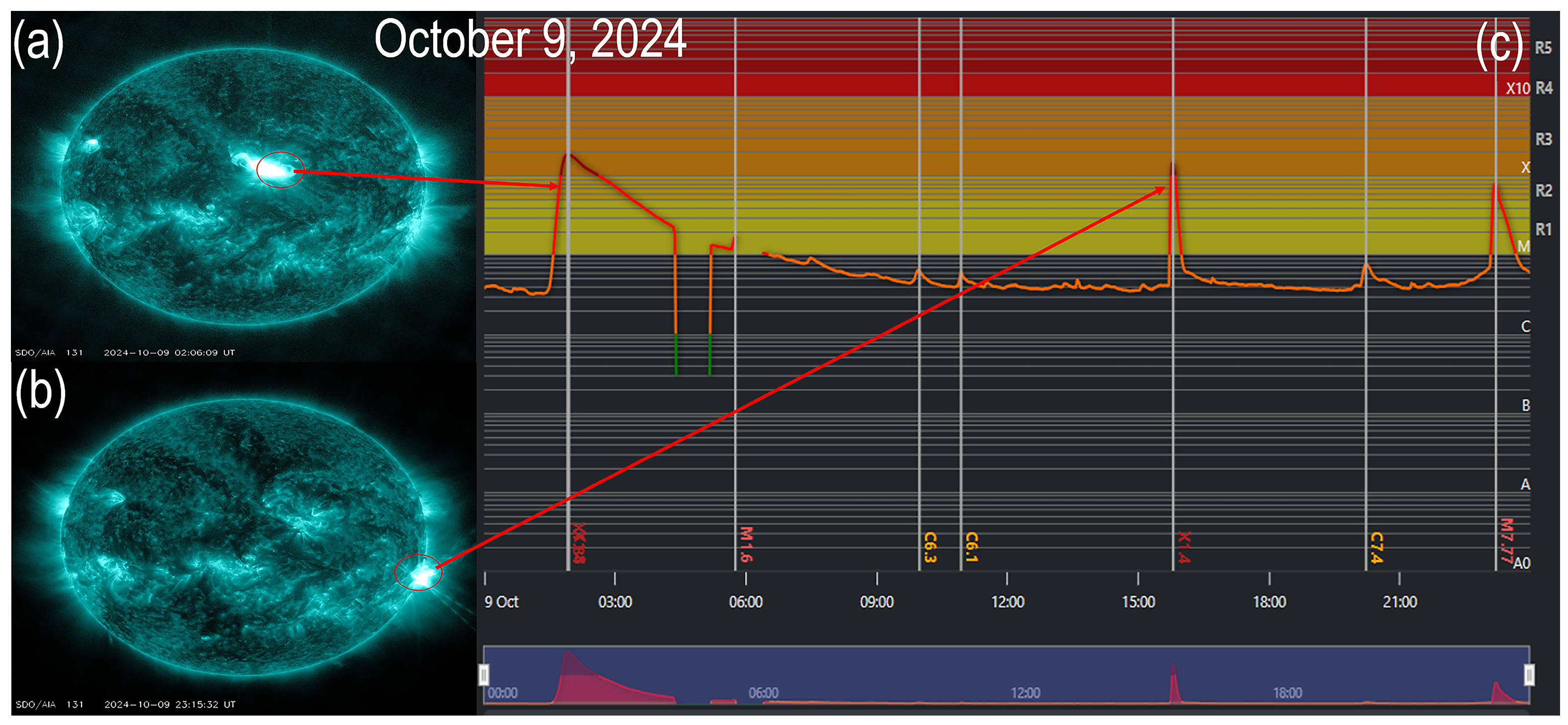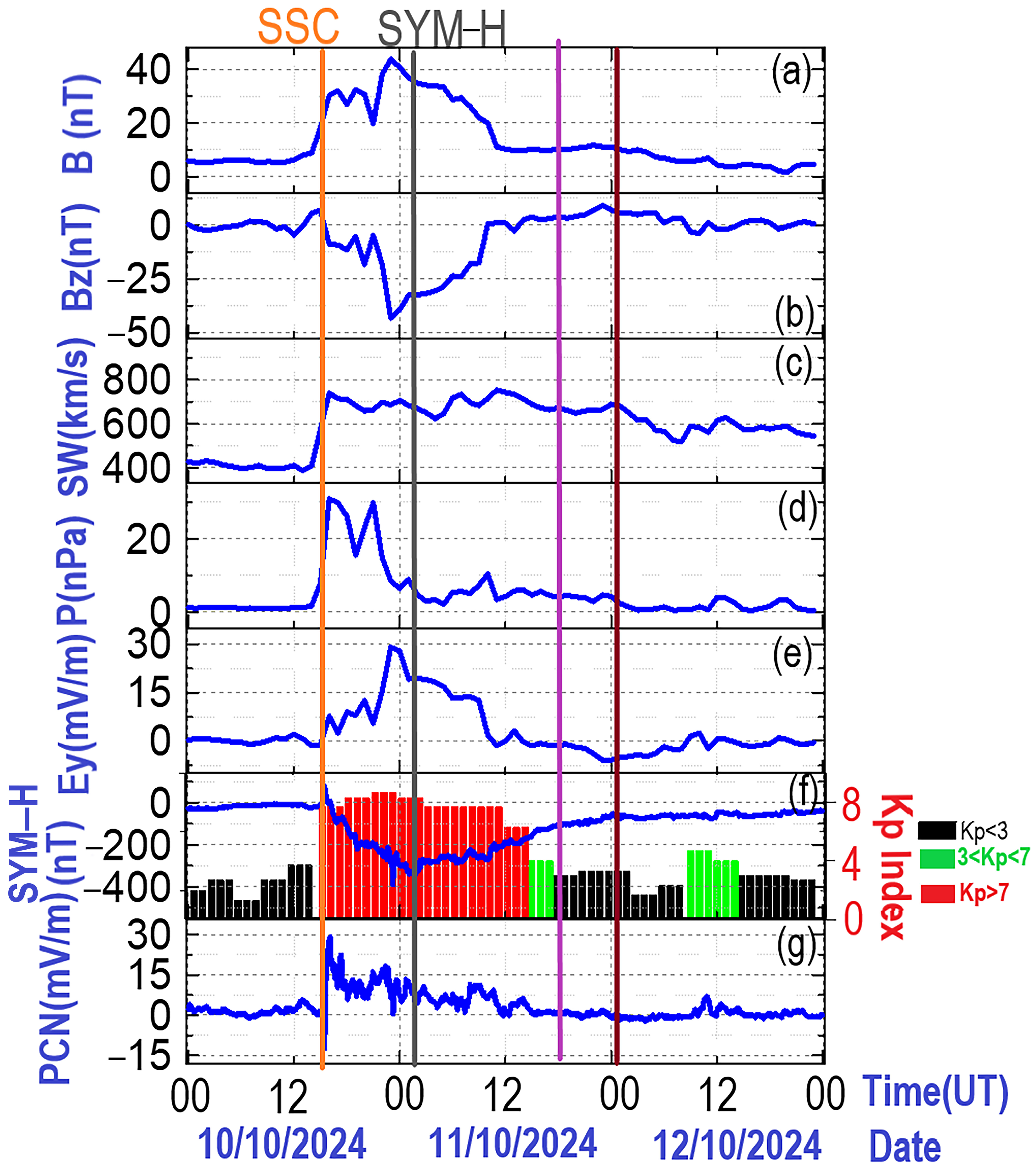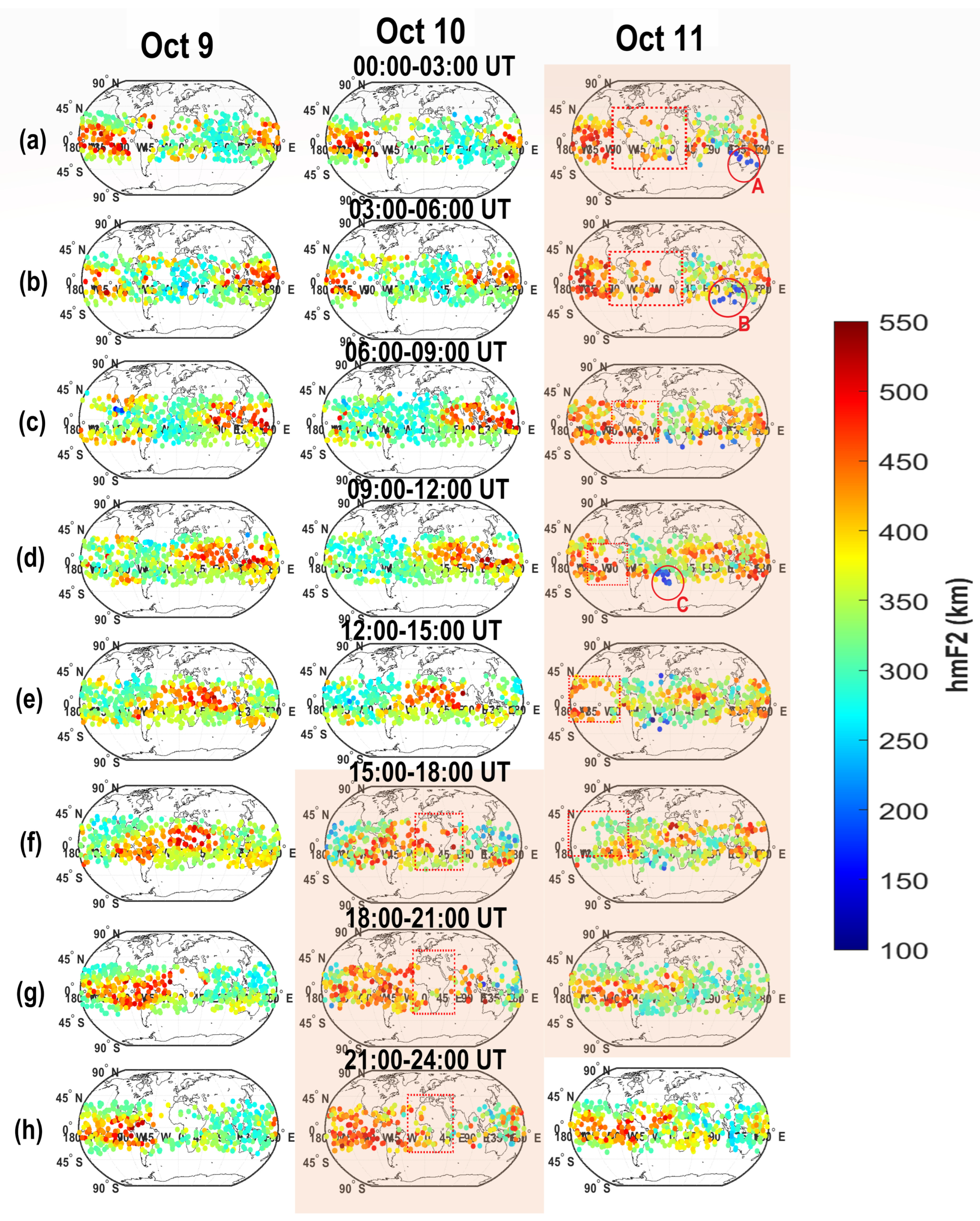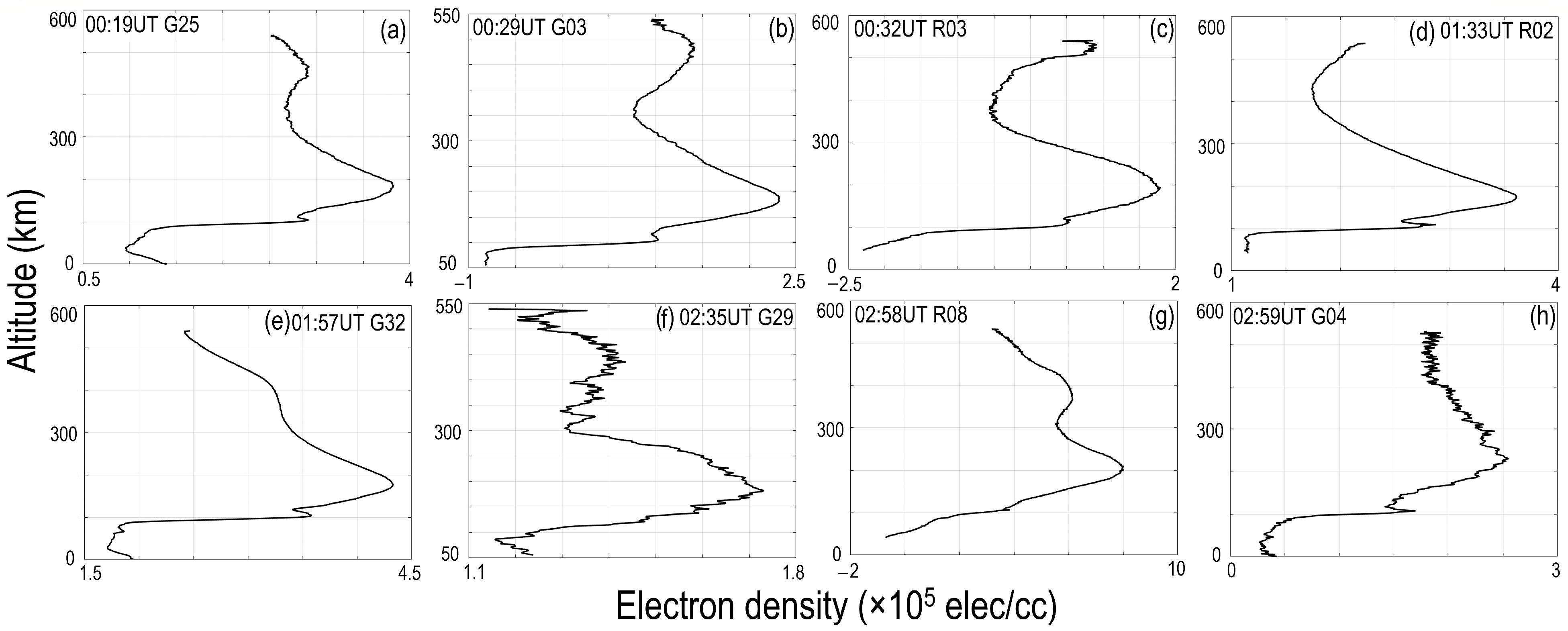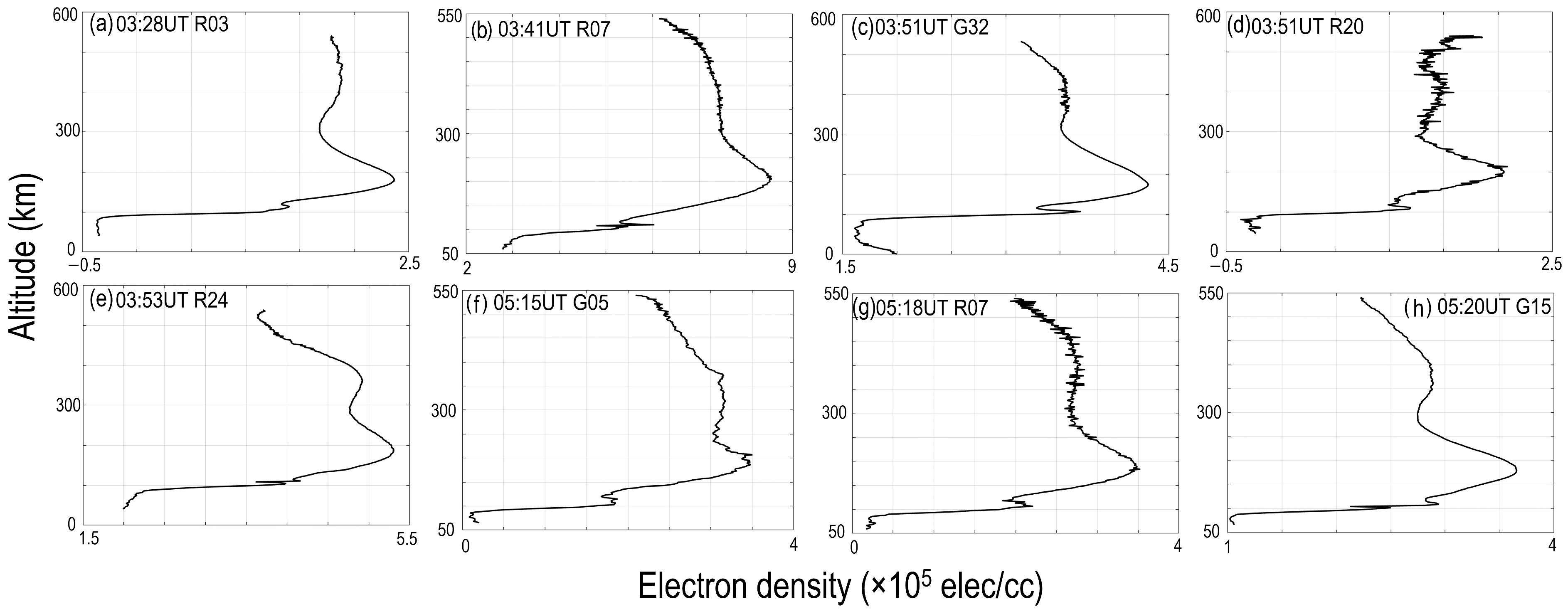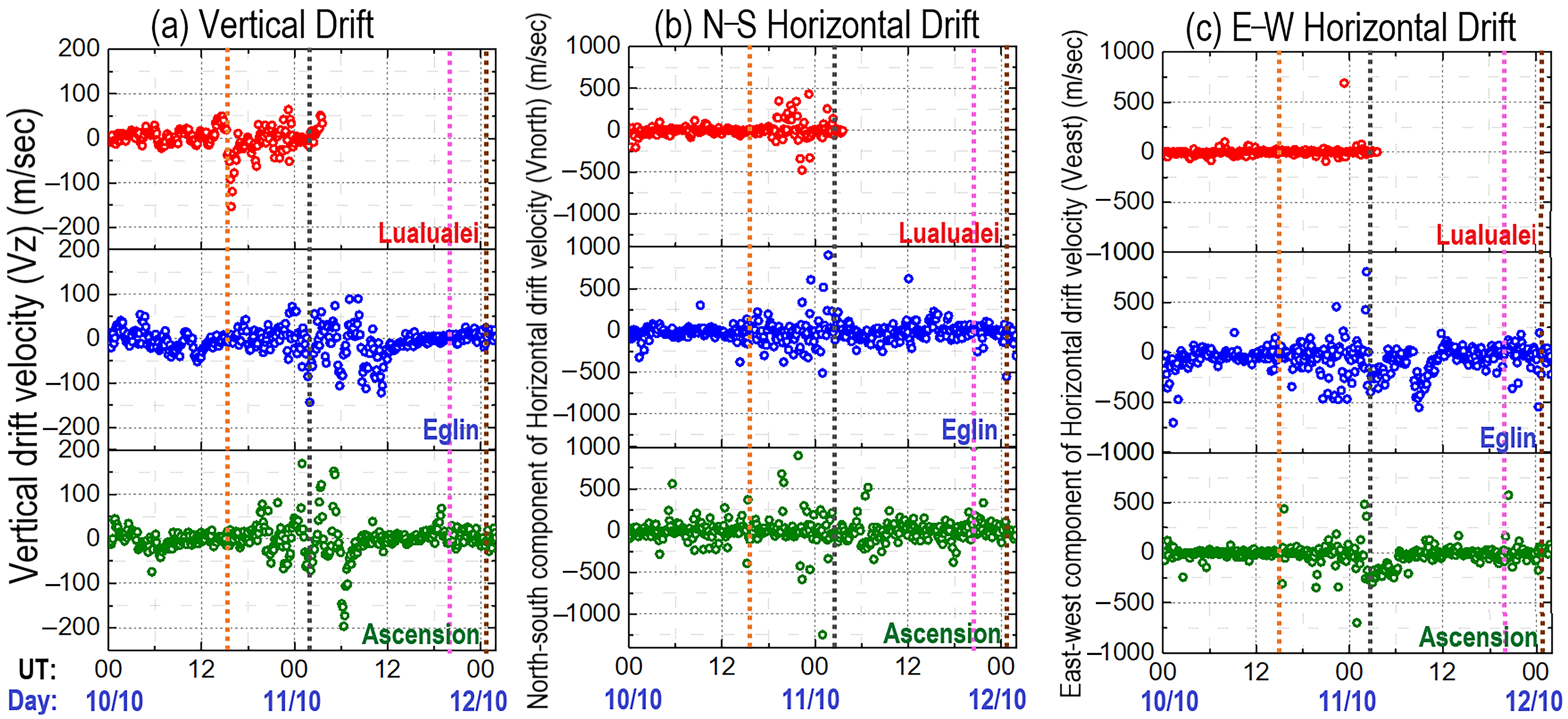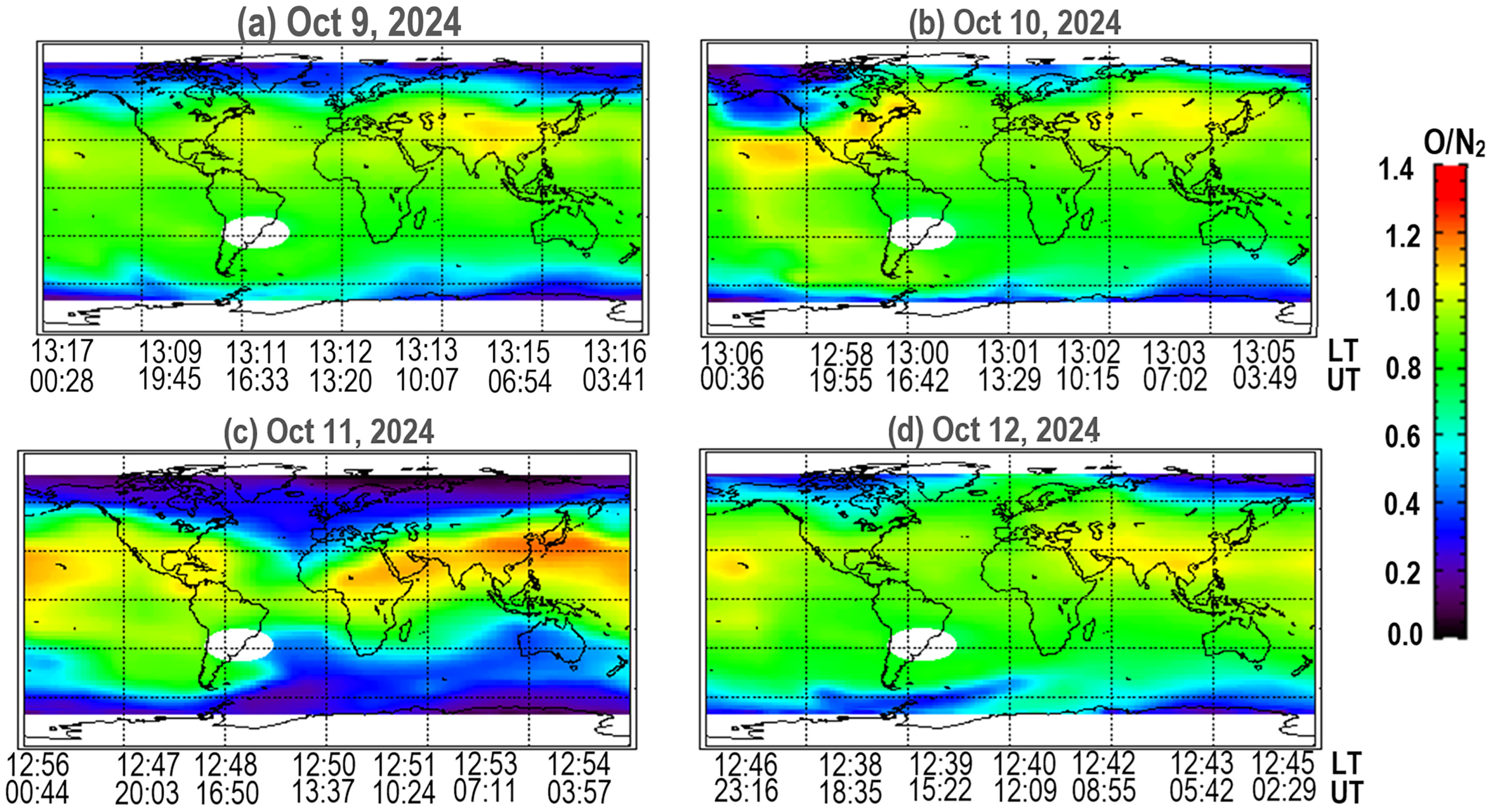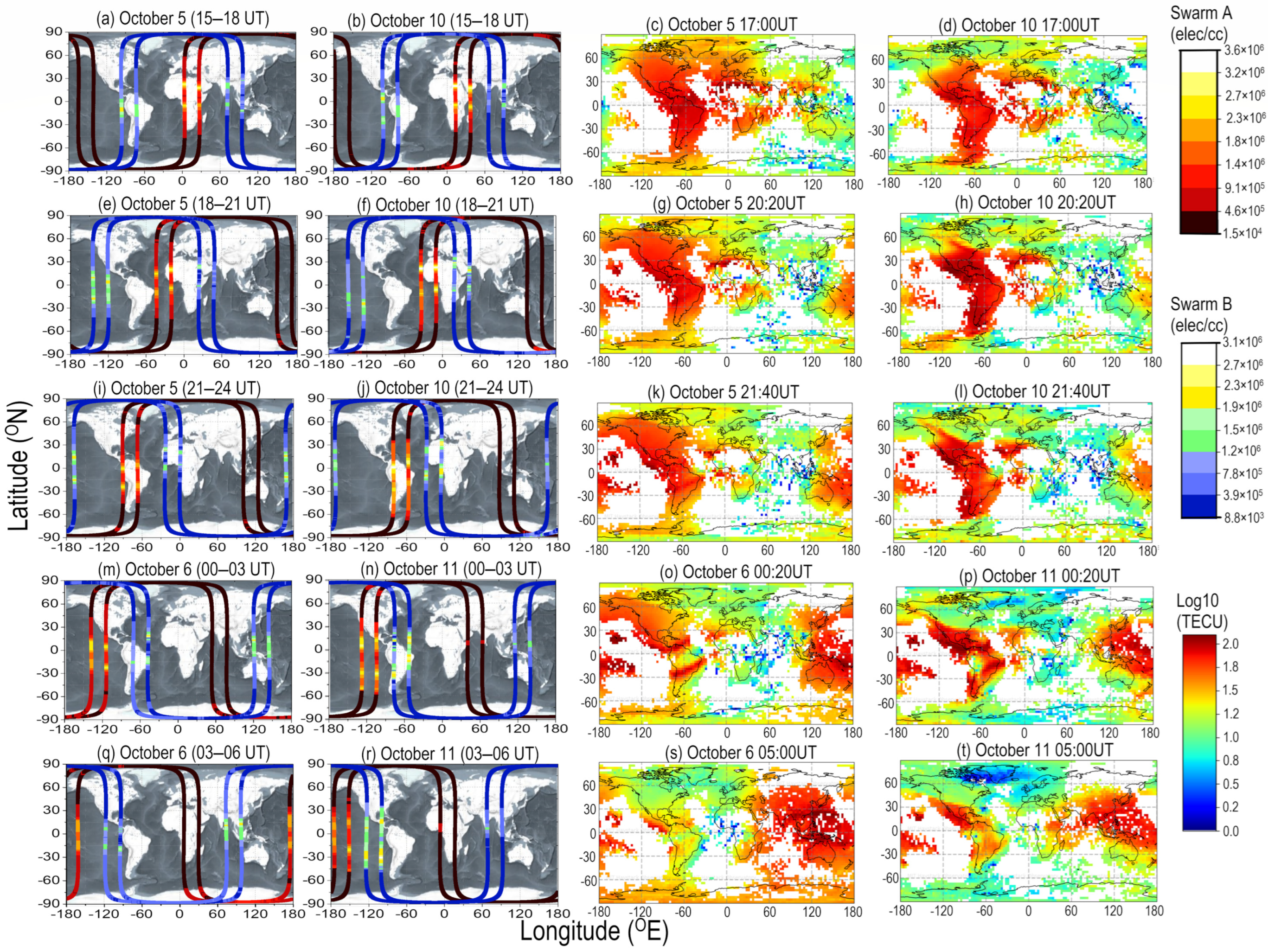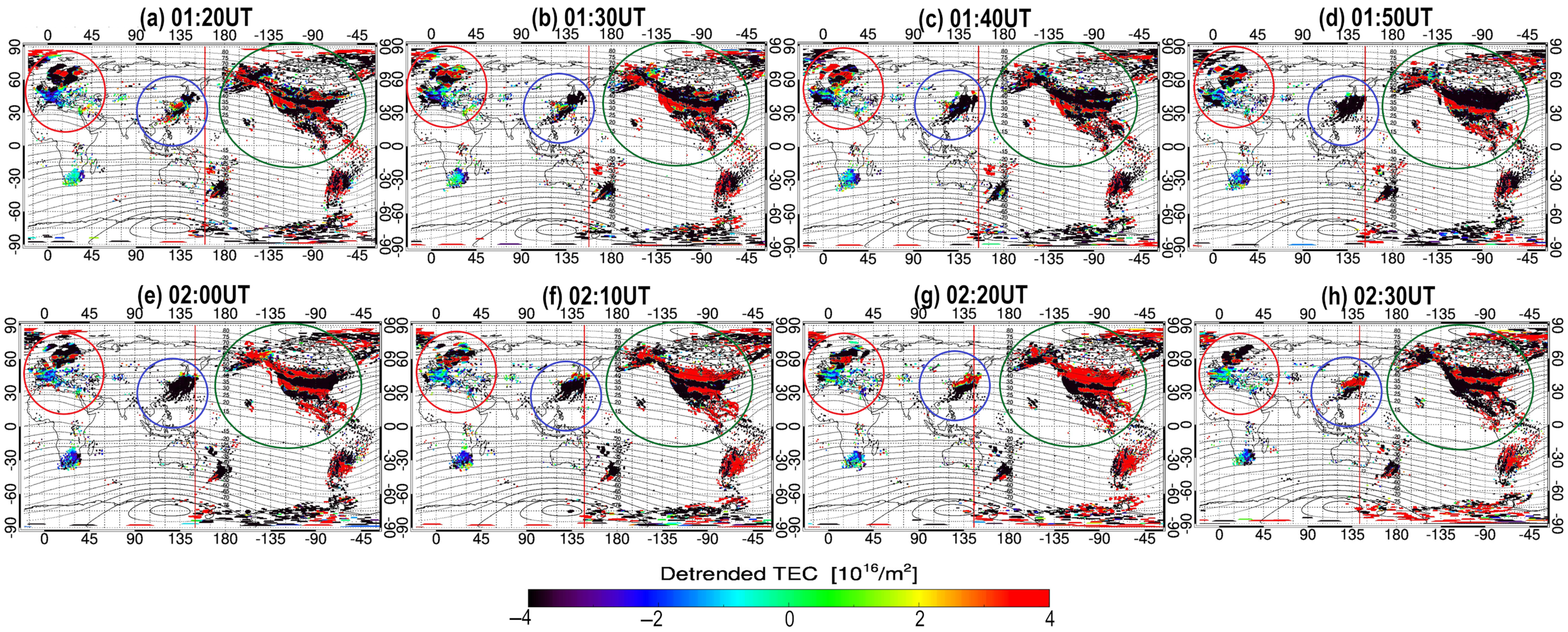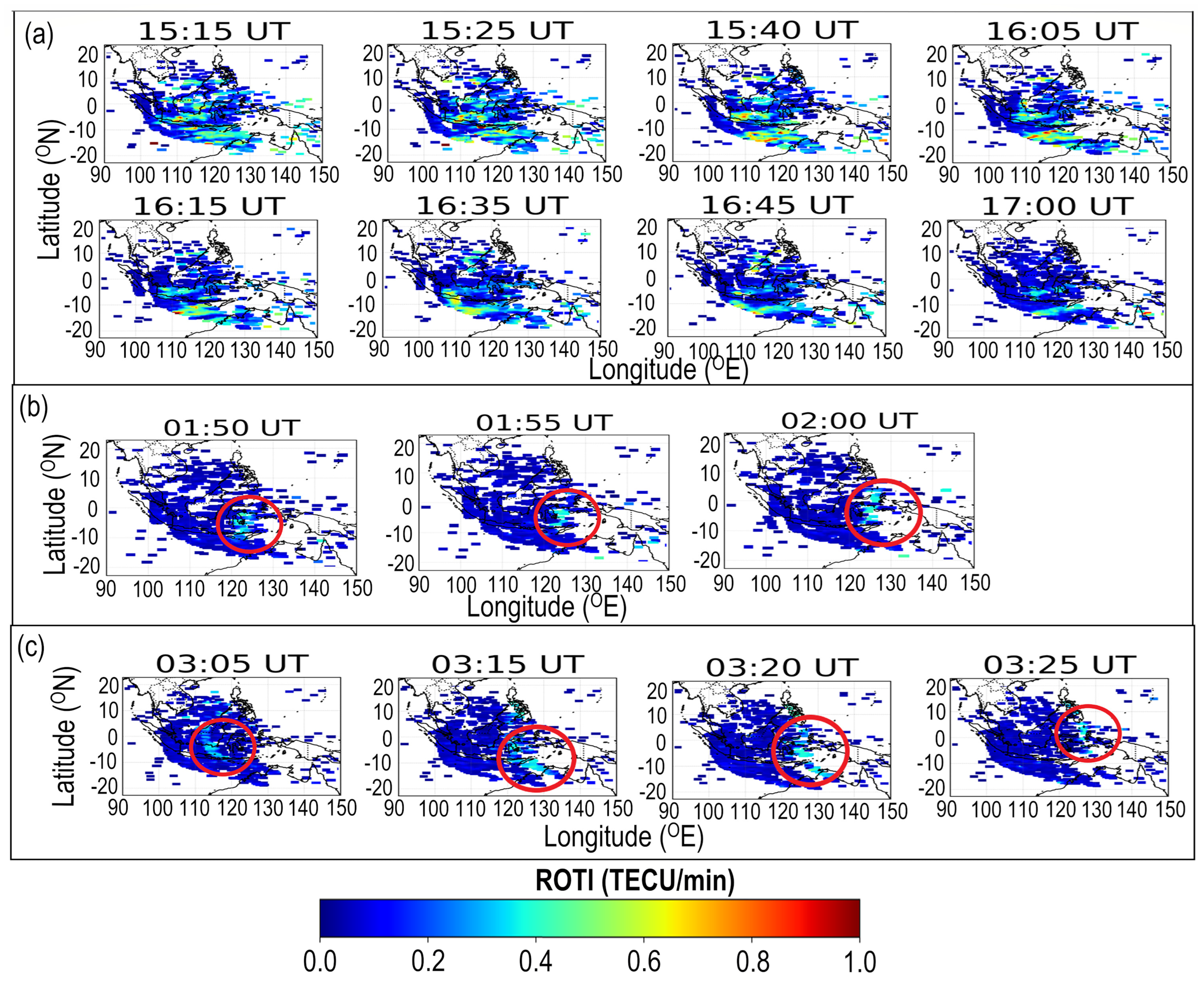1. Introduction
Geomagnetic storms have a profound influence on Earth’s ionosphere across all latitudes, triggering intricate physical processes in equatorial, midlatitude, and polar regions. These interactions complicate our understanding of space weather dynamics [
1,
2,
3,
4,
5,
6,
7]. Storm-time electric field and energy input from the magnetosphere can induce rapid ionospheric responses, sometimes intensifying ionospheric instabilities [
8,
9], while at other times suppressing them [
10,
11], depending on local conditions and time scales.
During Solar Cycle 25, two significant geomagnetic storms—classified as G4 and G5—occurred in 2024, coinciding with a peak in solar activity. The most intense of these was the G5-class “Mother’s Day Storm” on 10–11 May 2024 (Kp~9), one of the strongest storms since 1957. This event generated auroras visible at midlatitudes (~45°N and ~37°S) [
12,
13]. Spogli et al. (2024) [
14] reported major space weather effects over Italy, notably a substantial drop in plasma density on 11 May, resulting in a negative ionospheric storm evident in both F-layer critical frequency (foF2) and total electron content (TEC). This was linked to changes in the thermospheric composition, particularly a decrease in the [O/N2] ratio. High values of the Rate of TEC Change Index (ROTI) were also observed, associated with Stable Auroral Red (SAR) arcs and a southward shift in the ionospheric trough. The ROTI enhancement was attributed to low-latitude plasma being driven poleward by pre-reversal enhancement (PRE) after sunset, along with northward-propagating wave-like disturbances. Karan et al. (2024) [
13], using NASA’s GOLD imager, identified a connection between the southern crest of the Equatorial Ionization Anomaly (EIA) and auroral activity near the southern tip of South America. The EIA crest shifted poleward at speeds up to 450 m/s, and auroral emission extended to midlatitudes over Southern Africa and South America, resulting in midlatitude plasma erosion. Themens et al. (2024) [
15] described a significant uplift in the Storm-Enhanced Density (SED) plume, with the F2-layer height (hmF2) rising by 150–300 km and GNSS scintillation observed across the auroral oval. Bojilova et al. (2024) [
16] reported Hemispheric asymmetries in the ionospheric response due to particle precipitation and thermospheric heating, along with EIA modifications and disturbance dynamo electric fields (DDEFs) at lower latitudes. Paul et al. (2025) [
5] investigated the ionospheric response over Europe during the Mother’s Day storm using Digisonde data and Swarm satellite measurements. They found notable Ne depletion, attributed to the equatorward shift in the Midlatitude Ionospheric Trough (MIT). Large-Scale Travelling Ionospheric Disturbances (LSTIDs) and Spread F were also evident, primarily at higher midlatitudes. A broader study by Paul et al. (2025) [
6] showed global-scale F2-layer uplift and increased foF2 over midlatitude dayside regions, while nightside values decreased. Enhanced vertical and horizontal plasma drifts were observed, including ~170 m/s upward drift in the Southern Hemisphere during the storm’s main phase. Swarm A measurements indicated EIA expansion to 60°S on the dayside and 40°S on the nightside.
The second major G4-class storm occurred on 10–11 October 2024. This event has received limited attention so far. Pierrard et al. (2025) [
17] were among the first to offer an analysis, comparing the October storm to the May G5 event. Using Vertical TEC (VTEC) and ionosonde data from Europe, the USA, and South Korea, they found that upper atmospheric ionization initially spiked after Coronal Mass Ejection (CME) arrival, followed by a prolonged depletion lasting over 24 h. Recovery began on October 12, whereas the May event showed an unusually fast rebound. These effects were attributed to intense F-layer perturbation, further amplified by plasmaspheric contribution to VTEC variation. Picanço et al. (2025) [
18] described a reversed C-shaped depletion band stretching from the magnetic equator to auroral latitudes. This feature was driven by intensified vertical drift at the equator and zonal drift at higher latitudes, causing the polar irregularity region to extend into midlatitudes and merge with elongated equatorial plasma bubble (EPB) structures around ~45° MLAT. They observed longitudinal asymmetry in EPB development: along South America’s western coast (~0° MLON), EPB activity appeared at midlatitudes, while along the eastern coast (~20° MLON), it remained equator-bound. These patterns were linked to differences in electric field penetration efficiency due to seasonal changes in ionospheric conductivity. Additionally, DDEFs sustained elevated F-region altitudes and triggered rare post-sunrise EPBs.
By incorporating a wide range of satellite and ground-based observations, the present analysis investigates the global ionospheric response to the 10–11 October 2024 geomagnetic storm. Using Constellation Observing System for Meteorology, Ionosphere, and Climate—2 (COSMIC—2) RO profiles, in situ Ne measurements from Swarm satellites, ion drift data from Digisondes, and global TEC maps, the analysis offers a comprehensive view of storm-time ionospheric dynamics, particularly over equatorial and midlatitude regions and at higher altitudes where significant plasma redistribution occurs. Additional validation from far-ultraviolet emissions from the GUVI instrument aboard TIMED supported the findings. The present article is organized into six sections.
Section 1 provides an overview of existing literature on both May and October 2024 geomagnetic storms, offering essential context and comparative insight into the characteristics, impact, and underlying dynamics of these two significant space weather events.
Section 2 describes the data sources and the methodology.
Section 3 examines the solar and geomagnetic activity associated with the event.
Section 4 presents the results, followed by
Section 5, which discusses the findings in the context of physical processes driving ionospheric variability. Finally,
Section 6 summarizes the key observations and insights.
2. Data and Methods
As a first step in our investigation of the 10–11 October 2024 geomagnetic storm, we examined solar activity using solar and solar wind data from the SOHO/LASC–C2 instrument. These observations, covering the period from 10 to 12 October 2024, were accessed via the SOHO data repository (
https://soho.nascom.nasa.gov/data/data.html accessed on 23 April 2025) to identify key solar features such as CMEs and their potential geoeffectiveness. To characterize geomagnetic conditions during the storm, we utilized high-resolution (1 min) OMNI data provided by NASA’s Goddard Space Flight Center (
http://omniweb.gsfc.nasa.gov accessed on 23 April 2025) and supplemented it with geomagnetic indices from the International Service of Geomagnetic Indices (
https://isgi.unistra.fr/indices_asy.php accessed on 23 April 2025).
To analyze the ionospheric response globally, we focused on F2-layer peak characteristics—foF2 and hmF2—across low to midlatitudes from the COSMIC—2 RO mission, provided by the University Corporation for Atmospheric Research (UCAR). Specifically, we used Level 2 “ionPrf” data files from the COSMIC Data Analysis and Archive Center (CDAAC), which contain electron density (Ne) profiles with respect to altitude derived via Abel inversion from slant TEC observations. Due to the low inclination of COSMIC—2 satellites, coverage is optimized for latitudes within ±35° magnetic (~±45° geographic), making it ideal for equatorial and low- to midlatitude ionospheric studies [
6].
To examine ionospheric drift velocities during the storm, we extracted vertical (Vz) and horizontal (Vnorth and Veast) drift velocities from the University of Massachusetts Lowell Center for Atmospheric Research (UMLCAR) Digisonde drift database (
https://lgdc.uml.edu/common/DFDBFastStationList accessed on 23 April 2025). Due to limited data availability, we focused on three stations: Lualualei (21.43°N–158.15°E), Eglin (30.5°N–86.5°E), and Ascension Island (−7.95°N–14.4°E). Drift velocities from 00:00 UT on 10 October to 02:00 UT on 12 October were extracted using the DriftExplorer (version 1.2.14) tool (
https://ulcar.uml.edu/Drift-X.html accessed on 23 April 2025), offering insight into the electric field-driven plasma transport across different latitudes.
Thermospheric composition data, particularly the atomic oxygen to molecular nitrogen ratio [O/N
2], were obtained from the Global Ultraviolet Imager (GUVI) instrument onboard the TIMED spacecraft. These data, covering the period from 10 to 12 October, were accessed from the GUVI data portal (
http://guvitimed.jhuapl.edu/data_products accessed on 25 April 2025) with October 6 as a reference. This compositional ratio serves as a critical indicator of neutral atmospheric dynamics that influence electron density during geomagnetic storms.
In addition to these datasets, we analyzed in situ Ne measurements from the Swarm A and B satellite Langmuir probes (LP), accessed through the ESA VirES platform (
https://vires.services/ accessed on 24 April 2024). The Swarm mission consists of three identical satellites (Swarm A, B, and C) in near-polar orbits, with Swarm A and C initially orbiting at ~465 km and Swarm B at ~520 km [
19]. These high-altitude, high-resolution observations are essential for capturing storm-induced changes in Ne at F-region altitudes.
To support a comprehensive global-scale analysis of ionospheric variability, we employed TEC data derived from the Madrigal database (
http://www.haystack.mit.edu accessed on 24 April 2025)—a widely recognized open-source platform developed by the MIT Haystack Observatory. Madrigal (Millstone Analysis and Data Reduction Interactive Graphical Analysis Language) is a distributed data system that hosts and serves a wide range of geospace science data, including ionospheric and upper atmospheric measurements. It enables users to perform advanced data searches and supports access to standardized data formats that are compatible with systems such as the NCAR CEDAR data archive [
6]. Specifically, we utilized global GPS-derived TEC maps available through Madrigal’s “Distributed Ground-Based Satellite Receivers” instrument category, and more precisely from the “Worldwide GNSS Receiver Network” dataset. This dataset provides near-real-time, globally distributed TEC maps generated from ground-based GNSS observations. The TEC values are mapped into a regular spatial grid of 1° latitude × 1° longitude, with a temporal resolution of 5 min, offering high-resolution coverage suitable for monitoring large-scale ionospheric structures and their temporal evolution. For this study, we extracted global TEC maps spanning the interval from 18:00 UT on 10 October to 18:00 UT on 11 October. These maps represent processed and calibrated TEC data, which are derived through the integration of dual-frequency GNSS signal phase delays measured at a global network of ground-based receivers. The integration time for each global TEC map is approximately 20 min, providing a temporally smoothed view of ionospheric electron density distribution across the globe. The selected dataset spans more than two decades (1998 to present), making it one of the most comprehensive and accessible sources for long-term ionospheric research.
To investigate the activity of LSTIDs during the main phase of the geomagnetic storm, we employed global detrended TEC (dTEC) maps spanning from 15:00 UT on 10 October to 03:00 UT on 11 October. These maps were obtained from the GPS-TEC database maintained by Nagoya University (
https://stdb2.isee.nagoya-u.ac.jp/GPS/GPS-TEC/GLOBAL/MAP/index.html#Oct%202024 accessed on 26 April 2025), which offers multiple two-dimensional ionospheric data products, including the absolute TEC, the TEC difference ratio (rTEC), the detrended TEC (dTEC), and the ROTI. All data products are provided in geographic coordinates with a temporal resolution of 10 min. The dTEC maps used in this study are generated using data from over 9300 GNSS receivers distributed globally. The global RINEX files used for generating these maps were collected through international collaboration with the DRAWING-TEC project managed by the National Institute of Information and Communications Technology (NICT), Japan (
https://aer-nc-web.nict.go.jp/GPS/DRAWING-TEC/ accessed on 26 April 2025). To derive dTEC values, the bias estimation technique proposed by Otsuka et al. (2002) [
20] was applied, ensuring accurate baseline corrections. The dTEC product specifically isolates ionospheric anomalies by removing long-term trends from the TEC data. For improved spatial resolution and reduced noise, the data are gridded at 0.25° × 0.25° in geographic latitude and longitude and smoothed using a 5 × 5 grid boxcar averaging method. This enhances the spatial continuity of the ionospheric features while preserving significant perturbation signatures associated with LSTIDs.
Although the previously discussed global dTEC maps provide comprehensive coverage of ionospheric perturbations, their spatial resolution and data density are notably limited over the Southern Hemisphere, particularly in the Asian-Australian longitude sector. To address this gap and enable a more detailed investigation of ionospheric irregularities in this region, we utilized ROTI data from the Ina-CORS GNSS network, available through the BRIN Ionospheric Map Service (
https://gatotkaca.brin.go.id/petaionosfer/ionosphericmap/roti_map/ accessed on 20 June 2025) for the period spanning 15:00 UT on 10 October to 20:00 UT on 11 October. The Ina-CORS network comprises approximately 300 GNSS receivers distributed across the Indonesian archipelago, covering a longitudinal range from 95°E to 140°E and a latitudinal extent from 5°N to 10°S. These stations record GNSS observations at a 30 s cadence, with data stored in the RINEX format. TEC values derived from these observations are used to compute the ROTI, which is defined as the standard deviation of the TEC rate of change over a 5 min sliding window. This metric is a well-established proxy for identifying ionospheric irregularities, particularly those associated with EPBs, which occur at spatial scales of a few kilometres. For visualization, ROTI values are mapped at an Ionospheric Pierce Point (IPP) altitude of 350 km, generating two-dimensional latitude–longitude grids at a resolution of 0.25° × 0.25°. To enhance spatial coherence and reduce noise, a 5 × 5 boxcar averaging filter is applied across the grid. ROTI maps are generated at 10 min intervals between 09:00 and 23:50 UT, offering high temporal resolution snapshots of ionospheric activity over Indonesia. The ROTI map grid consists of a 241 × 161 matrix, encompassing a geographic area bounded by longitudes 90°E to 150°E and latitudes −20°N to 20°N. Missing data points are denoted by “NaN” values.
3. Solar and Geomagnetic Activity
The October 2024 geomagnetic storm was triggered by two highly active solar regions identified by NOAA as AR3848 and AR3842. These regions generated a series of powerful solar flares, including two classified as X-class—the most intense category, known for their strong X-ray emissions and frequent association with fast and wide CMEs. On 9 October, AR3848 and AR3842 collectively produced two M-class, three C-class, and two X-class flares (
Figure 1a–c). The first of these, an X1.8 flare from AR3848, began at 01:25 UT, peaked around 01:56 UT, and ended by 02:43 UT. Later that day, an X1.4 flare from AR3842 erupted, starting at 15:44 UT, peaking at 15:47 UT, and fading by 15:53 UT (
https://www.spaceweatherlive.com/en/archive/2024/10/09/xray.html accessed on 23 April 2025). The first CME associated with the X1.8 flare was observed by SOHO/LASCO to be ejected from AR3848 at 02:12 UT on 9 October (
https://kauai.ccmc.gsfc.nasa.gov/CMEscoreboard/prediction/detail/3670 accessed on 23 April 2025), and it reached Earth by 15:00 UT on 10 October, travelling at an average speed of ~1200 km/s. Multiple eruptions throughout 9 October led to successive CMEs, which merged into a complex interplanetary structure, producing a strong interplanetary (IP) shock detected near Earth around 15:00 UT.
The arrival of this IP shock at Earth’s magnetosphere triggered a Sudden Storm Commencement (SSC) at 15:16 UT on 10 October, as shown in
Figure 2a–g as an orange line. At the time of SSC, the 1 min SYM—H index (equivalent to the hourly Dst index) spiked from 11 nT to 78 nT (
Figure 2f), a signature of intensified magnetopause current. Immediately afterwards, the SYM—H index began to fall sharply, indicating the onset of the storm’s main phase. This phase continued until the index reached a minimum of −346 nT at 01:46 UT on 11 October, as depicted by the grey line in
Figure 2a–g. A gradual recovery followed, with the SYM—H returning to near pre-storm levels by 00:26 UT on 12 October as shown by a brown line. A notable intermediate recovery point occurred around 19:38 UT on 11 October, when the index rose above −100 nT (pink line). Between SSC and 23:14 UT on 10 October, the SYM—H index exhibited notable oscillations, linked to fluctuations in the interplanetary magnetic field Bz component (IMF—Bz). Peaks in SYM—H corresponded to northward (positive) IMF—Bz, indicating a more closed magnetospheric configuration, while decreases aligned with sustained southward (negative) IMF—Bz conditions, favourable for magnetic reconnection and energy input into the magnetosphere.
To further assess geomagnetic activity, we examined the global Kp index (
Figure 2f), which peaked at 6+ between 15:00 UT on 10 October to 14:00 UT on 11 October, confirming the severity of the event. The Kp index declined significantly afterwards, marking the storm’s recovery phase.
High-latitude geomagnetic activity was evaluated using the Polar Cap Index for the Northern Hemisphere (PCN), which is calculated from magnetic field variation recorded at the Qaanaaq station in Greenland. PCN data averaged over 15 min intervals are used to detect geomagnetic disturbances in the polar caps caused by the solar wind’s dynamic pressure and orientation of the IMF [
21]. As expected, PCN showed a marked increase in response to the CME impact and tracked closely with Kp, particularly when Kp exceeded level 7, indicating enhanced auroral electrojet activity. On 10 October at approximately 15:00 UT, coinciding with the SSC, solar wind speed jumped sharply from 409 km/s to 740 km/s (
Figure 2c), confirming the CME’s arrival. At the same time, IMF—Bz turned strongly negative (
Figure 2b), while the total magnetic field strength (IMF—B) showed multiple successive increases, consistent with the passage of a complex CME structure. These conditions facilitated prolonged and intense dayside magnetic reconnection at the magnetopause, enabling massive energy transfer into Earth’s magnetosphere. After 00:30 UT on 12 October, IMF—Bz returned to near-zero, and IMF—B weakened to about 4 nT, signalling the end of the storm’s active phase. The long duration and sustained southward orientation of IMF—Bz was a consequence of one of the most geoeffective geomagnetic storms in the recent solar cycle.
5. Discussion
The present study focuses on the storm-induced global ionospheric response to the October 2024 storm, with the following impacts highlighted in
Section 4.
A storm-induced F-region uplift manifested as an increase in hmF2, observed on the dayside in both Hemispheres. This enhancement occurred while foF2 remained largely stable, except in the American longitude sector during the storm’s early active phase. Conversely, a marked decrease in foF2, accompanied by uplift of the F-region, was detected on the nightside of the Southern Hemisphere during both the initial and main phases of the storm, as shown in
Figure 3a–h and
Figure 4a–h. Certain nighttime longitude sectors displayed missing foF2 and hmF2 values during the storm period, highlighted by red rectangles in
Figure 3a–h and
Figure 4a–h, a pattern also noted during the Mother’s Day 2024 superstorm [
6]. During the main and early recovery phases, extremely low hmF2 values were recorded over some isolated regions in the Southern Hemisphere’s nightside sector, as indicated by regions A, B, and C in
Figure 4.
Section 4 attributes these to G-conditions, which are further illustrated in
Figure 5a–h,
Figure 6a–h and
Figure 7a–h, where COSMIC Ne profiles show foF1 exceeding foF2 and the F1 layer emerging as the Ne peak—most evident between 00:00 and 12:00 UT.
The substantial F-region uplift during the storm is corroborated by strong vertical plasma drifts recorded at Eglin and Lualualei in the Northern Hemisphere and Ascension Island in the Southern Hemisphere (
Figure 8a). Swarm B data also indicated considerable Ne depletion over the dayside (
Figure 10), implying that the F2 peak was over the observational range of COSMIC—2.
The ionospheric response at high latitudes is initially driven by Joule heating, which raises upper thermospheric temperatures and accelerates neutral wind via ion drag. This heating initiates a global wind surge from polar to lower latitudes and into the opposite Hemisphere, often manifesting as a large-scale GW. This circulation creates midlatitude wind patterns, with GW and background wind representing complementary aspects of the same process. The surge, which favours the nightside and magnetically conjugate regions, is UT-dependent. Meanwhile, the thermospheric composition bulge—characterized by enhanced molecular nitrogen [N2] and reduced atomic oxygen [O]—is shaped by both background and storm-driven winds, not merely Earth’s rotation. During geomagnetic storms, storm-time winds determine its location, while background winds modulate its diurnal variation during recovery.
The rise in hmF2 is mainly due to equatorward wind that uplifts the F-region, while the drop in foF2, especially in sunlit areas, is tied to increased molecular nitrogen enhancing recombination and reducing Ne. These effects vary with local time and longitude, reflecting the spatial complexity of storm-time ionospheric responses. Increases in foF2—“positive phases”—typically occur on the dayside due to ionospheric uplift and equatorward plasma transport, known as the “dayside ionospheric superfountain.” These are driven by strong southward IMF, which induces a dawn-to-dusk electric field that promotes plasma convection. Though direct measurements are limited, models by Vasyliūnas (1969) [
27] and Fuller—Rowell et al. (1994) [
28] support these mechanisms. On the nightside, low background ionization obscures positive phases, but dusk-time uplift can extend their effects. Negative phases, in contrast, are linked to the movement of the composition bulge and intensified thermospheric changes. This uplift matches the model proposed by Fuller—Rowell et al. (1994) [
28], where meridional winds lift plasma and alter the composition. Global divergent winds also induce upwelling and redistribution of thermospheric species. Additional uplift may result from the equatorward expansion of the polar ionosphere and poleward EIA movement. Picanço et al. (2025) [
18] noted polar irregularities reaching ~45° magnetic latitude and asymmetrical EPB behaviour over South America—confined to the equator in São Luís but extending to midlatitudes—merging with auroral structures. This likely caused a strong F-region uplift apparent on ionograms, as supported by Paul et al. (2025) [
6] and
Figure 4. Strong F-region uplift was observed globally during both the storm’s main and recovery phases (
Figure 4a–h), with vertical drift speeds exceeding 100 m/s (
Figure 8a). The most intense uplift occurred over Ascension Island, accompanied by enhanced hmF2 at other Southern Hemisphere stations. These effects are attributed to PPEFs driven by southward IMF—Bz and increased Ey electric field. PPEFs can reach the ionosphere at 5–10% of the upstream field strength [
29]. As per Vasyliūnas (1969) [
26], such electric fields result from the solar wind–polar cap interactions, producing eastward PPEFs and upward E × B drift. Around 16:00 UT on October 10, IMF—Bz dropped from 6.8 nT to ~−8.9 nT, sustaining the uplift. During recovery, a positive IMF—Bz-initiated DDEF gradually shifts ionospheric dynamics. As Blanc and Richmond (1980) [
30] explained, auroral heating triggers equatorward wind, forming Hadley-like circulation and reversing quiet-time electric patterns. The combined effect of DDEFs and PPEFs explains the widespread F-region uplift during the October 2024 storm.
Throughout 10–11 October, negative ionospheric storm effects were evident on the nightside of the Southern Hemisphere, whereas on the dayside, particularly during the storm’s active and recovery stages, elevated F-trace heights occurred without a significant increase in foF2. This suggests ionospheric uplift without corresponding Ne enhancement at COSMIC—2 sampling altitudes. Interestingly, Pierrard et al. (2025) [
17] noted a slight foF2 increase over midlatitude Europe during the same storm, in contrast to COSMIC—2 data. This discrepancy may be due to G-conditions, as shown in
Figure 5a–h,
Figure 6a–h and
Figure 7a–h, where the F2 peak may have risen above COSMIC—2’s range, leading to underdetection by satellite instruments but detection by ground-based ionosondes, as reported by Pierrard et al. (2025) [
17]. This underscores the need for combined satellite and ground-based observations for a comprehensive understanding of ionospheric storm dynamics.
A clear poleward expansion of the EIA and the associated Hemispheric asymmetries in the ionospheric response to the October 2024 geomagnetic storm were observed. Swarm A in situ Ne measurements (
Figure 10a–t and
Figure 11a–t) distinctly capture the EIA expansion during the initial and main phases of the storm. These observations are further supported by intensified eastward plasma drift recorded at Eglin and Ascension Island (
Figure 8c), highlighting the significant role of electric field dynamics in modulating storm-time plasma transport. While the poleward expansion of the EIA during the October 2024 storm was previously noted by Picanço et al. (2025) [
18], the present study offers a more comprehensive, global perspective using Swarm satellite data, capturing the evolution of the EIA across both Hemispheres and multiple longitude sectors.
A key emphasis is placed on the Hemispheric asymmetry of the storm-time ionospheric response, which is attributed to variations in particle precipitation and thermospheric heating. These processes enhance ionization while simultaneously increasing recombination rates, ultimately leading to Ne depletion. This asymmetry is strongly influenced by the day—night variation in Hall conductivity, which modulates the electrodynamic response between Hemispheres. During severe geomagnetic storms, the electric field associated with the equatorial “superfountain” effect becomes substantially more intense than that under quiet conditions. As described by Tsurutani et al. (2008) [
29], a strong southward IMF drives a dawn-to-dusk electric field on the dayside, enhancing upward E × B drift and lifting the equatorial F-region to much higher altitudes and latitudes. This vertical transport carries plasma into regions where recombination is slower, allowing solar photoionization to restore plasma densities at lower altitudes and contribute to Ne increase. The result is an intensified and poleward-expanded EIA, with plasma densities enhanced not only in altitude but also in latitude due to continued E × B convection. However, unlike earlier storms, Hemispheric asymmetry during the October 2024 event has not yet been widely reported in the literature, likely due to its recent occurrence and a limited number of processed case studies. Our results, particularly the post-storm hmF2 drop (
Figure 4) and asymmetrical EIA behaviour, underscore the need for closer examination of the thermospheric and electrodynamic drivers of this response. In contrast, the Hemispheric asymmetry associated with the May 2024 “Mother’s Day” superstorm has been more extensively documented. For instance, Bojilova et al. (2024) [
16] conducted a comprehensive global analysis, highlighting Hemispheric differences at mid and high latitudes arising from enhanced particle precipitation and thermospheric temperature gradients. Their findings also emphasized low-latitude coupling via DDEFs, which modulated the EIA distinctly between Hemispheres. Foster et al. (2024) [
12] attributed observed westward and equatorward auroral surges at midlatitudes to low-energy electron precipitation, which induced Hemispherically asymmetric westward plasma drifts. Guo et al. (2024) [
31] identified storm-time thermospheric circulation as a key factor in producing east–west asymmetries, adding a longitudinal dimension to Hemispheric divergence. Xu et al. (2013) [
32] further linked southern polar heating to longitudinal mass density anomalies, extending to mid- and low latitudes. Aa et al. (2012) [
33] likewise reported that enhanced Joule heating near the southern magnetic pole (~140°E) can propagate thermospheric effects across the equator, ultimately affecting the low-latitude ionosphere and producing asymmetric enhancements in [O/N
2] ratios.
LSTID excitation was clearly observed during the main phase of the October 2024 storm (
Figure 12,
Figure 13,
Figure 14,
Figure 15,
Figure 16 and
Figure 17), closely linked to the storm-time thermospheric disturbances and compositional changes. The observed irregularities in Swarm Ne coincide with [O/N
2] ratio reduction (
Figure 9), which enhances ion recombination and plasma loss [
34]. These compositional shifts, driven by particle precipitation and Joule heating in the polar regions, modify the thermospheric circulation and are often accompanied by LSTIDs. Previous studies highlighted the link between auroral activity and LSTID generation. Borries et al. (2010) [
24] found a clear correlation between AE index peaks and LSTID amplitudes, while Paul et al. (2025) [
5] reported intense spatial and temporal variations in the ionosphere were driven by MIT displacement during the storms, coupled with LSTID signatures. LSTIDs, generated at high latitudes, propagated equatorward during the initial and main phases of the storm. Zhang et al. (2022) [
25] and Oikonomou et al. (2022) [
7] attributed LSTID formation to the intense storm-time electric field and expanded high-latitude convection field. These fields, combined with enhanced thermospheric westward wind and ion-neutral coupling, trigger ionospheric instabilities with significant growth rates. As the wind decouples from high-coupling regions, it supports the propagation of LSTIDs across middle and low latitudes. PPEFs, which rapidly map from the magnetosphere to the low-latitude ionosphere during strong southward IMF conditions, also play a crucial role. Their zonal and meridional components influence vertical and zonal plasma drift, affecting EIA and EPB formation [
35]. Subsequent shielding and overshielding responses can alter or reverse these effects at mid- and low latitudes. In addition to the direct electric field effect, disturbance dynamo processes driven by storm-time neutral wind introduce the anti-Sq current systems. These include westward and poleward electric fields during the day and the eastward field at night, especially at midlatitudes [
30]. Collectively, these electrodynamic and thermospheric interactions create favourable conditions for LSTID excitation and amplification during intense geomagnetic storms.
The ROTI maps over the Southeast Asian equatorial ionosphere reveal clear signatures of storm-induced EPBs during the geomagnetic storm of 10–11 October 2024. During the storm’s initial phase (15:00–17:00 UT), corresponding to local nighttime, intense ionospheric irregularities (>1 TECU/min) appeared in the Southern Hemisphere around 15:15 UT, peaked near 15:40 UT, and dissipated by 16:45 UT, with a noticeable southwestward movement. These EPBs are consistent with previous studies [
26,
36] showing that super EPBs can form during geomagnetic storms due to the combined effects of PRE and PPEFs, leading to rapid vertical rise and latitudinal expansion. Similar post-sunset EPB activity was also reported by Abadi et al. (2025) [
26] over Southern Australia during the 2024 Mother’s Day storm. In the recovery phase, weaker perturbations (~0.4 TECU/min) were observed near the equator around 01:50 UT and 03:05–03:25 UT, likely driven by DDEFs, which are known to suppress or weakly trigger EPBs during post-midnight hours.
